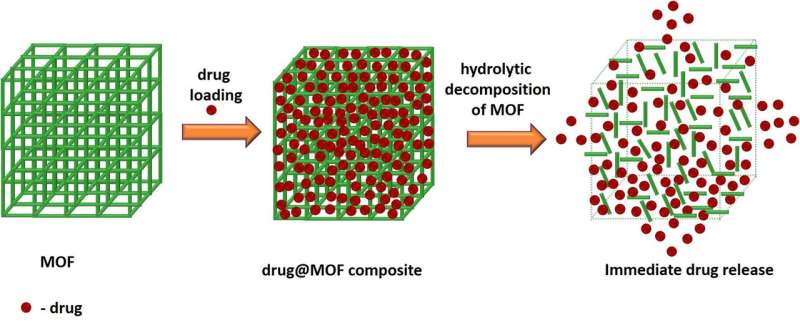Just add water: Chemists suggest a fix for insoluble drugs

Stable metal organic frameworks are prized for their ability to capture carbon dioxide or harvest atmospheric water, but U-M researchers have developed a use for unstable metal organic frameworks: as a system for drug delivery.
Ninety percent of drugs in development don't dissolve well or at all in the body, according to a 2012 study. Metal organic frameworks, or MOFs, are rigid, porous structures composed of metal linked by organic ligands. While researching unstable MOFs, U-M chemist Adam Matzger realized they may work as a delivery system for these kinds of drugs.
"It struck us that while everyone was shooting for stable MOFs, we could use what we had learned about instability of MOFs to get a degradable substance that would rapidly release drugs. It was a really unexpected finding," said Matzger, the Charles G. Overberger Collegiate Professor of Chemistry and a professor of macromolecular science and engineering.
The MOF delivery system takes advantage of one strategy of delivering insoluble drugs, Matzger says. The strategy is to deliver them in an amorphous form, meaning that the drugs are kept from crystallizing. Once the drug compounds crystallize, they become less soluble—and therefore less bioavailable, which means less of the drug crosses into the bloodstream.
MOFs are able to keep these drugs in an amorphous state because of their porous structure. MOF-5 in particular looks like a set of cubes stacked on top of each other: picture an endlessly repeating 3-D grid. When the researchers load a drug into this grid, the pores in the MOF compartmentalize the drug molecules, holding the compound in the desired amorphous state.
Researchers have previously used polymers to hold drug compounds in an amorphous state, but drug molecules could still migrate and crystallize in the polymer, which affects solubility and therefore how much of a drug is bioavailable. Because MOF rigidly holds drug molecules apart but quickly decomposes, drug dosage is easily controlled, Matzger says. The compound itself crosses into the bloodstream, while the MOF decomposes in the body.
The researchers, who include postdoctoral fellow Kuthuru Suresh, decided to use MOF-5 for a few reasons. First, its metal component is zinc, a metal with low toxicity used in many supplements, and the organic component is an acid called terephthalic acid. Second, MOF-5 is relatively unstable, which the researchers demonstrated in separate work that examined the stability of different MOFs.
"What we do here is we increase the solubility while guaranteeing dosage stability," Matzger said. "This approach is relatively universal. We show it for three drugs, but the fact that the pores are too small to allow a crystal to form is going to be true for all drugs."
More information: Adam J. Matzger et al, Enhanced Drug Delivery by Dissolution of Amorphous Drug Encapsulated in a Water Unstable MOF, Angewandte Chemie (2019). DOI: 10.1002/ange.201907652
Journal information: Angewandte Chemie
Provided by University of Michigan




















